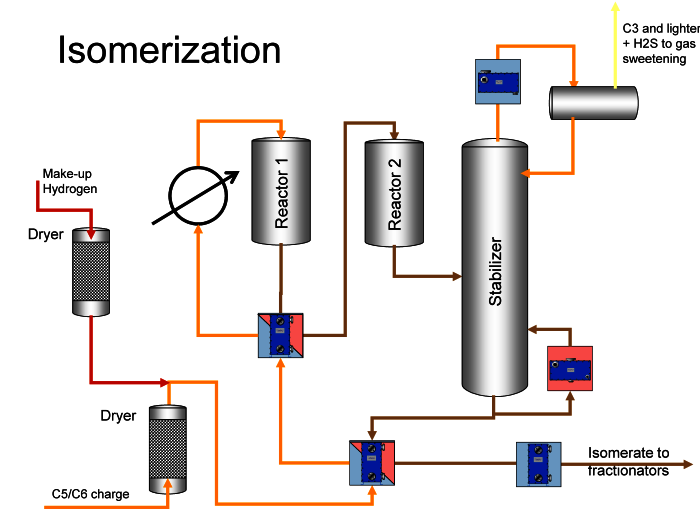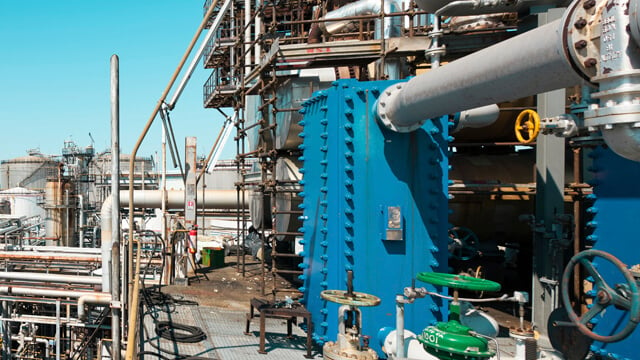Isomerisation von leichtem Naphtha
Um den Ertrag von Benzin mit hohem Oktanwert zu steigern, ist eine Isomerisierung erforderlich, bei der n-Butan oder n-Pentan/n-Hexan als Ausgangsstoff für Alkylierung oder Blending umgewandelt wird. Durch effizientes Vorwärmen und maximale Energieeffizienz lassen sich die Kosten dafür deutlich reduzieren. Compablocs von Alfa Laval otpimieren die Wärmerückgewinnung bei geringem Platzbedarf.
Optimizing refinery isomerization processes
Upgrading the octane number of light naptha fractions maximizes high-octane gasoline yields. Our process expertise and Alfa Laval Compabloc heat exchangers help you save energy, cut costs, increase production and ultimately boost profitability.
Energy efficiency for light naphtha isomerization
In isomerization processes, there are several critical positions for energy recovery, which contributes to the overall profitability of the plant.
Firstly, the feedstock is preheated to the reaction temperature by means of the reactor effluent. The more energy that is recovered in this position, the less energy is needed for the final heating of the feedstock and less capacity is required for the final cooling of the effluent before the separator.
In a similar manner, maximizing energy recovered from the fractionator bottoms stream used to heat the fractionator feed, minimizes the energy consumption of the fractionator reboiler as well as the cooling requirements of the isomerate.
Using compact Alfa Laval Compabloc heat exchangers for these duties maximizes energy recovery on minimal plot space. Return on investment can generally be realized within 12 to 18 months based on energy savings alone. When increasing process capacity is also included as part of the revamp, typical payback times may be cut to less than 12 months.
Capacity increase
Increasing the capacity of an existing isomerization unit can be difficult and expensive, especially if the capacity of the hydrogen recycle compressor is limited and must be upgraded.
By replacing existing traditional shell-and-tube heat exchangers with an Alfa Laval Compabloc exchanger that is designed to recover more heat with a lower combined pressure drop, it is possible to offload both the final heater and effluent cooler as well as the compressor. This provides the increase in capacity without requiring any additional investment in equipment.
Similarly, replacing the traditional shell-and-tube heat exchangers with Compabloc exchangers with higher capacities and maximum energy recovery in the fractionation section also helps offload the fractionator reboiler and isomerate final cooler, thereby minimizing investment in such equipment.
Minimizing CAPEX
What’s more, using Compabloc exchangers in heat recovery applications instead of several large shell-and-tube heat exchangers in series further reduces the total installed costs of equipment.
This is especially true when Compablocs are installed as overhead condensers, where minimal plot space and flooded weight are key factors in minimizing heat exchanger capital expenditures.
Proven technology for refinery ligtht naphtha isomerization
Alfa Laval has Compabloc heat exchangers installed in isomerization units around the world. These operate as reactor feed/effluent interchangers, fractionator feed/bottoms interchangers, condensers and reboilers and isomerate final coolers, saving energy, increasing production and boosting yields.


